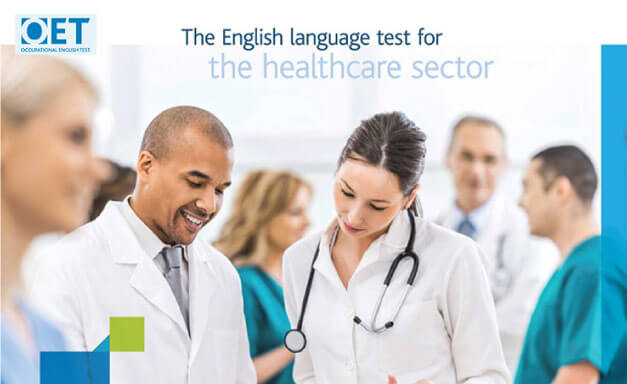The OET (Occupational English Test) assesses the English language communication skills of healthcare professionals who wish to practice in an English-speaking environment. The exam is accepted across the majority of regulators, hospitals and universities in the UK, Ireland, Australia, New Zealand, Dubai, Singapore, and Namibia. The Occupational English Test (also known as OET) was developed to test healthcare professionals’ English communication abilities. OET tests English language ability in four areas: Listening, Reading, Writing and Speaking.

Test takers will need to demonstrate their ability to understand and answer questions about general healthcare consultations and presentations, in addition to texts in a general healthcare setting. Test takers are required to write accurate, professional letters with the aid to prompts and use speaking prompts to carry out appropriate and effective conversations with the patients, relating to specific healthcare professions.
OET was designed in the late 1980s by Professor Tim McNamara, in the University of Melbourne, under the guidance of the Australian National Office for Overseas Skills Recognition (NOOSR), which administered the test at that time. Since March 2013 the test has been owned by Cambridge Boxhill Language Assessment Trust (CBLA), a venture between Cambridge English Language Assessment and Box Hill Institute.
OET can be taken by healthcare professionals in any of the following 12 professions: Dentistry, Dietetics, Medicine, Nursing, Occupational Therapy, Optometry, Pharmacy, Physiotherapy, Podiatry, Radiography, Speech Pathology, and Veterinary Science.
You can apply to take OET by visiting www.occupationalenglishtest.org/apply-oet/. When you register to take OET, you might only be able to select from the next two available test dates, so you should aim to begin revising for the test before applying. To apply online, you will need to refer to an identification document and upload a colour passport photograph of yourself.

OET provides a valid and reliable assessment of all four language skills – Listening, Reading, Writing and Speaking – with an emphasis on communication in medical and health professional settings. OET consists of four sub-tests:
| Listening | 40 minutes | Listen and understand a range of recordings in healthcare topics from different healthcare settings |
| Reading | 60 minutes | Read and understand various texts on healthcare topics from different healthcare settings |
| Writing | 45 minutes | write a letter, usually a referral letter using information provided in patient case notes |
| Speaking | 20 minutes | communicate with a patient in real life context through the use of role-plays |
OET Grades |
OET Band Descriptors |
IELTS Scores | PTE Scores |
|---|---|---|---|
|
Grade-A 450-500 |
Can communicate very fluently and effectively with patients and health professionals using appropriate register, tone and lexis. Shows complete understanding of any kind of written or spoken language |
9.0 8.5 8.0 |
86-90 83-85 79-82 |
|
Grade-B 350-440 |
Can communicate very fluently and effectively with patients and health professionals using appropriate register, tone and lexis with only occasional inaccuracies and hesitations. Shows good understanding in a range of clinical contexts. |
7.5 7.0 |
73-78 72-65 |
|
Grade-C+ 300-340 |
Can maintain the interaction in a relevant healthcare environment despite occasional errors and lapses, and follow standard spoken language normally encountered ,in his/her field of specialization |
6.5 |
64-58 |
|
Grade-C 200-290 |
Can maintain some interaction and understand straight forward factual information in his/her field of specialization, but may ask for clarification. Frequent errors, inaccuracies and mis-or-overuse of technical language can cause strain in communication. |
6.0 5.5 |
57-50 49-43 |






















Crossland Education & Careers
SCO 85, Near Mangaldeep, Bridge Market, Sector 17C, Chandigarh, 160017
Call: 090717 75577